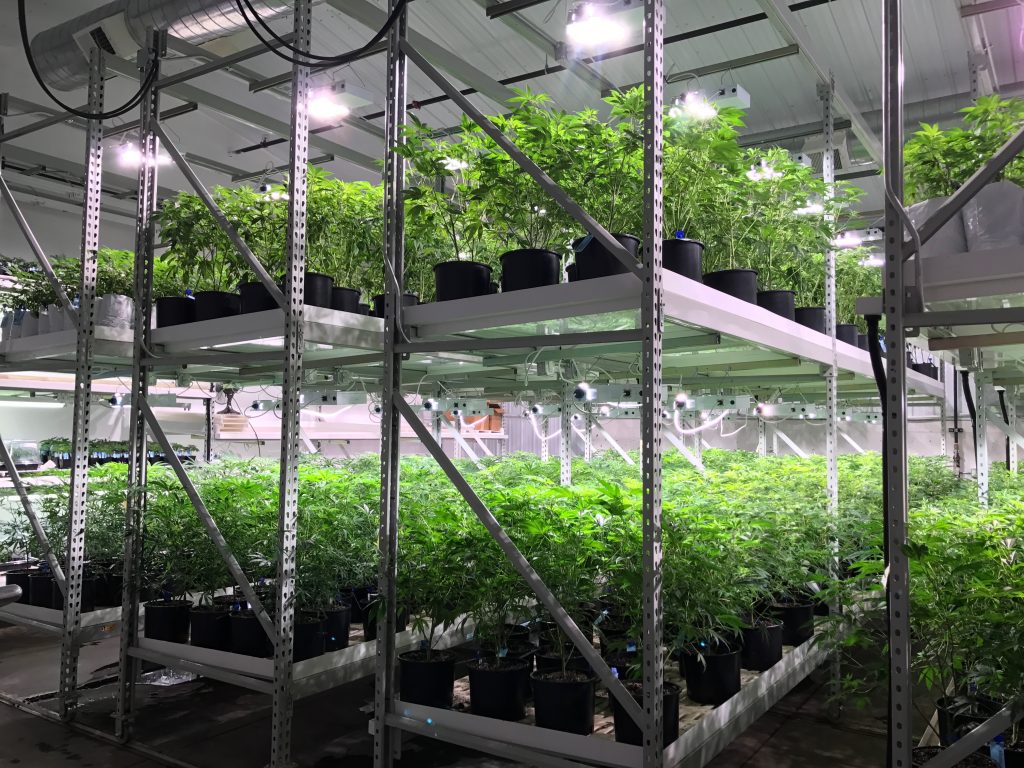Vertical grow facilities are sprouting up in commercial cultivation operations around the world—and for good reasons. Thanks to technological advances and cost considerations, cultivators are maximizing the amount of flower per square foot they can grow by utilizing vertical space. But why exactly has this trend taken off so quickly throughout the industry?
What is vertical cultivation?
Vertical grow room designs use special racks that stack cannabis plants one above the other, with lights on the underside of each shelf. The vertical cultivation arrangement prevents the canopies of rows of plants from overshadowing other rows.
Vertical grow systems are particularly compatible with hydroponic and automated cultivation methods that take advantage of low-touch techniques like crop steering that lend themselves to dense arrangements of plants. In fact, vertical cultivation wasn’t really feasible until certain technologies like these became widespread—particularly LED lighting.
LED lighting is crucial for vertical grow systems because these types of grow lights don’t get as hot as the traditional High-Intensity Diod (HID) lights that have been popular for decades. Because they run at a lower temperature, LED lights can be placed in closer physical proximity to growing cannabis plants without scorching their leaves or overheating their root zones.
A standard thousand-watt HID light needs to be seated four to six feet away from plants. But bar-style LED lights like those from Gavita or Fluence are designed with multi-tier grow facility designs in mind, calibrated to sit just a foot or two from the top of each canopy without providing too harsh an intensity of either light or temperature.
Vertical grow yields
A higher yield per square foot serves as one of the primary reasons that cannabis cultivators are investing in vertical grow systems. Most cannabis operators rent their cultivation facilities. It’s much easier to meet those per-square-foot operating costs like rent when growers can also maximize their profits per-square-foot by upping yields from floor to ceiling. In fact, finding a way to fit more cannabis plants into a given footprint is one of the best ways to increase margins.
Doubling the cannabis canopy means doubling yields which doubles revenue, without doubling the production cost per pound of flower. The labor costs associated with vertical cultivation design will not be significantly higher than more traditional grow facility layouts. Even as revenue expands from higher vertical grow yields, labor costs will only increase by around 50% at the most.
Indeed, much of the equipment that makes multi-tier cultivation possible also reduces the number of times employees need to touch plants. Technologies like drip irrigation and lighting timers that replace time-consuming labor-intensive work such as hand-watering and brightness adjustments also make it possible to arrange plants more densely without requiring additional facility staff or time spent per plant.
How to convert to a vertical cultivation system
One of the first questions cannabis producers ask about vertical cultivation systems is how much it costs to convert a traditional grow to a multi-tier model. While it’s true that vertical agriculture is most easily accomplished with automated cannabis cultivation systems and centralized building management, those tools aren’t necessarily required to get started. With increased production revenue from initial vertical grow yields, operators can reinvest in facility upgrades over time.
For example, a grower might start with one additional tier of plants that are still manageable with hand watering before using added profits to invest in a third tier or an automated irrigation system. Keep in mind that automated growing equipment typically pays for itself over time, too, thanks to savings on input expenditures like the water bill and fertilizer purchases.
In addition, vertical cultivation designs that incorporate LED lights present cost savings due to the lower operating temperatures that the lights yield. When lights run cooler they demand less of HVAC systems, contributing to lower electricity bills over time. Whether investing in a smaller HVAC system from the outset with a new cultivation buildout or running a legacy system at a lower capacity, electricity savings can add up significantly over time while doubling or tripling production yields.
The best place to start is by talking to an experienced facility design consultant like Next Big Crop that routinely designs vertical cultivation systems. There’s nothing like customized advice on where to begin shifting grow rooms to vertical designs and how to upgrade equipment piece by piece while keeping disruptions to production cadence to a minimum.
Ready to talk about the possibilities? Let’s start a conversation.
